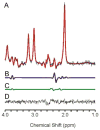Transcranial magnetic stimulation potentiates glutamatergic neurotransmission in depressed adolescents
- PMID: 26651598
- PMCID: PMC4716879
- DOI: 10.1016/j.pscychresns.2015.11.005
Transcranial magnetic stimulation potentiates glutamatergic neurotransmission in depressed adolescents
Abstract
Abnormalities in glutamate neurotransmission may have a role in the pathophysiology of adolescent depression. The present pilot study examined changes in cortical glutamine/glutamate ratios in depressed adolescents receiving high-frequency repetitive transcranial magnetic stimulation. Ten adolescents with treatment-refractory major depressive disorder received up to 30 sessions of 10-Hz repetitive transcranial magnetic stimulation at 120% motor threshold with 3000 pulses per session applied to the left dorsolateral prefrontal cortex. Baseline, posttreatment, and 6-month follow-up proton magnetic resonance spectroscopy scans of the anterior cingulate cortex and left dorsolateral prefrontal cortex were collected at 3T with 8-cm(3) voxels. Glutamate metabolites were quantified with 2 distinct proton magnetic resonance spectroscopy sequences in each brain region. After repetitive transcranial magnetic stimulation and at 6 months of follow-up, glutamine/glutamate ratios increased in the anterior cingulate cortex and left dorsolateral prefrontal cortex with both measurements. The increase in the glutamine/glutamate ratio reached statistical significance with the TE-optimized PRESS sequence in the anterior cingulate cortex. Glutamine/glutamate ratios increased in conjunction with depressive symptom improvement. This reached statistical significance with the TE-optimized PRESS sequence in the left dorsolateral prefrontal cortex. High-frequency repetitive transcranial magnetic stimulation applied to the left dorsolateral prefrontal cortex may modulate glutamate neurochemistry in depressed adolescents.
Keywords: Adolescent depression; Glutamate; Glutamine; Proton magnetic resonance spectroscopy; Repetitive transcranial magnetic stimulation.
Copyright © 2015 Elsevier Ireland Ltd. All rights reserved.
Figures



References
-
- Adalsteinsson E, Hurd RE, Mayer D, Sailasuta N, Sullivan EV, Pfefferbaum A. In vivo 2D J-resolved magnetic resonance spectroscopy of rat brain with a 3-T clinical human scanner. Neuroimage. 2004;22:381–386. - PubMed
-
- American Psychiatric Association. Diagnostic and statistical manual of mental disorders. 4. Washington, DC: 2000. Text revision.
-
- Benjamini Y, Hochberg Y. Controlling the false discovery rate: a practical and powerful approach to multiple testing. Journal of the Royal Statistical Society: Series B. 1995;57:289–300.
-
- Blazer DG, Kessler RC, McGonagle KA, Swartz MS. The prevalence and distribution of major depression in a national community sample: the National Comorbidity Survey. American Journal of Psychiatry. 1994;151:979–986. - PubMed
Publication types
MeSH terms
Substances
Grants and funding
LinkOut - more resources
Full Text Sources
Other Literature Sources
Medical

